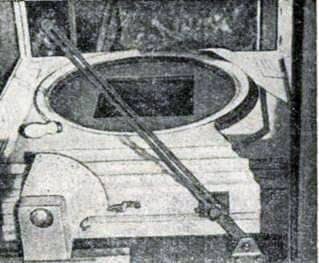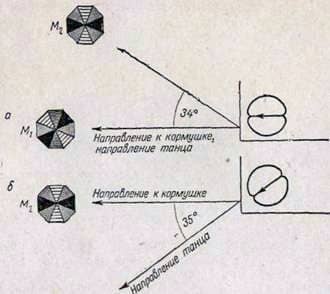Perception by bees of polarized light


Fig. 94. Observation beehive in an inclined position. Even with such a slight inclination bees can dance, guided by the direction of gravity.
To more accurately study the behavior of bees on a horizontal dance floor, it is best to use an observation beehive that can be tilted and fixed with a screw and nut in any position. If the honeycomb surface is inclined at least 15 њ, the dancers can already point the direction to the sun by wagging upwards and correctly show any angle between the direction to the feeder and the direction to the sun.
But if the cell lies horizontally, then it is impossible to run up it. Then the key referred to above is no longer suitable for indicating the direction. It’s funny to see how bees continue to dance with the same zeal in such circumstances, but without any orientation of the wagging run (since the sky is invisible to them). The direction of the run in this case is completely random and constantly changing. As soon as the dancer sees the sun or a piece of blue sky, the dances become oriented and point to the feeder.

Fig. 95. Observation hive in a horizontal position, closed from above by a rotating polarizer.
It has already been said that this amazing setting on the blue sky is due to the polarization of the heavenly light. A few words about how this can be proved.
In Fig. 95 shows the observation beehive in a horizontal position. Its glass walls above the honeycombs are closed by a board in which a quadrangular window is cut. Above him in a round rotating frame is placed a large polarizer. During the experiment, the hive is closed on three sides and the bees dancing on the honeycomb see through the window in the board a limited, for example northern part of the blue sky. The celestial light is partially
The polarizer converts it even more significantly, letting the rays pass with only one plane of oscillation. We now establish a rotating polarizer above the dancing bee so that the light rays passing through it retain the plane of oscillations that they had on the north side of the sky. In this case, the bees continue to dance correctly and indicate the actual direction to the feeder.
But just turn the polarizer, thus changing the direction of the polarized light, as the dancing bees deviate in the direction of the turn and show the wrong direction. The correction to the erroneous indication is not always exactly the same, with the angle to which the polarizer was rotated.
On which the magnitude of the wrong indication depends and whether it is really determined by the direction of the oscillations of the polarized light, one can check if using a polarizer. With respect to polarized light, it can be considered as a model of a separate bee eye in the complex composite organ of vision (facet eye) of the bee.
Looking through the polarizer to the sky, let’s try to figure out how it can affect the bee eye. As an example, consider this experience:
A group of numbered bees from a lying horizontally observant beehive takes the sugar syrup on a feeder located exactly in the west. Dancers can see part of the blue sky in the west, that is, towards the feeder. Their wagging runs point to the west. Let’s arrange a large round polarizer so that the direction of the oscillations of light from the western part of the sky remains unchanged. The bees continue to dance correctly. Their dance, obviously, corresponds to a sample of illumination, characteristic for the western part of the sky, which is determined by the direction of the oscillations of polarized light.

Fig. 96. Above: the bees take the syrup from the trough, located to the west of the observation beehive. If they are at the dance on the horizontal surface of the honeycomb see the western part of the sky, then point to the west. They are guided by a wobbling run according to the pattern of illumination M1, which they see directly in front of them when flying to the trough. The lower figure: by means of a polarizer the sample M1 is replaced for dancers by the sample M2. They indicate an erroneous direction, because during the flight to the trough saw the sample M2 at an angle of 34 њ to the right of the direction of their flight. (Compare with the top figure.)
This pattern can be seen by looking through the polarizer to the western part of the sky. When flying to the trough, the bees adhere to the direction in which they always see this pattern right in front of them. In the dance, they become so that when wagging the run, it is also always ahead. Therefore, they point to the right direction to the west.
If you turn the polarizer 30 њ counterclockwise, the direction of the dance will immediately change and the bees will point the direction 35 њ south. On the western part of the sky, through a hexahedral star-shaped polarizer, serving as a model for a complex bee-eye, we see a sample M1. We place the usual polarizer in front of the hexagonal polarizer and give it the same position as the polarizer occupying the hive; then we change sample M1 to sample M2. It can be assumed that such an action occurs in the bee eye.
If you again remove the polarizer located before the artificial eye and direct this eye to the sky, then the sample M2 will appear only in one place, namely 34 њ north of the western direction. Consequently, when flying from the hive to the feeder, the bees saw a sample M1 in front of them, and 34 њ to the right of them – sample M2 and should be held in such a way that a sample of illumination M2 appeared to the right of them. In the experiment, we showed them a sample of the illumination of M2 in the west, that is, moved to the left by 34 њ. They saw nothing other than this pattern, and orientated their dance on it, pointing the direction to 35 њ to the left of this sample, as in the flight to the feeder, with an error of only 1 њ.
Of course, only one such experience can not be considered reliable. However, after about 100 fully-varied experiments of this kind, the results were always basically the same, it became possible to assume with confidence that bees are guided by polarized light.
Perception by bees of polarized light
